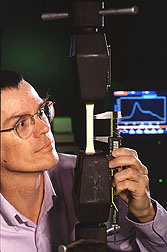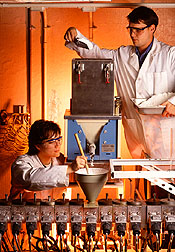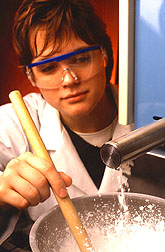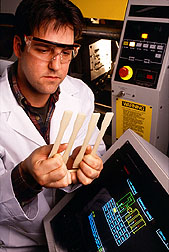Public-Private Partnership Boosts Public Benefits
In the early years of the 20th century, Peoria, Illinois, was a proving ground for new ideas and enterprises in the burgeoning entertainment field called vaudeville--so much so that the phrase, "How will it play in Peoria?" became a standard in the American vernacular. Eventually, the saying came to apply to everything from politics to fashion.
More than half a century later, a group of Peoria businessmen renewed the town's proving ground tradition in a totally different arena. They sought a way to bridge the gap between exciting discoveries made in government laboratories and a marketplace eager to receive those discoveries in a commercial form. The businessmen's goal was to marry government and academic research expertise with private industry's solid marketing know-how.
The resulting union was the Biotechnology Research and Development Corp., or BRDC, formed in 1988 and headquartered at the National Center for Agricultural Utilization Research in Peoria. NCAUR is operated by the Agricultural Research Service, USDA's chief research agency.
Unlike their neighbors down the hall at NCAUR, personnel in the BRDC do not conduct research.
Instead, they concentrate on "discovering and funding technology that holds promise to make a significant impact on the international marketplace," says BRDC's president and chief executive officer, J. Grant Brewen. Of special interest are agriculture-based technologies and new market opportunities for renewable agricultural commodities, such as corn, wheat, and soybeans.
|
|
Although agricultural commodities are often in the spotlight at BRDC, the corporation's creation was firmly rooted in the depressed industrial economy of the early 1980s. Among the founding members of the new venture was Del Schneider, who is now retired but was then chief executive officer of CILCORP Ventures, Inc., of Peoria, a subsidiary of CILCORP (Central Illinois Light Corporation). Schneider sought a way to spur economic growth for the Peoria area.
"Mr. Schneider put forth the idea for BRDC with the goal of diversifying the community's industrial base, which relied heavily on the manufacture of construction equipment," recalls Thomas Romanowski, vice president of finance for CILCO, also a subsidiary of CILCORP.
Built on Legislative Supports
Important federal legislation passed in the mid-1980s helped make BRDC a workable reality--specifically, the Federal Technology Transfer Act of 1986 that smoothed the way for government researchers and private enterprise to work together. This legislation allowed government agencies such as the Agricultural Research Service to establish cooperative research and development agreements (CRADAs).
In return for signing on as partners on a project under a formal CRADA, industry cooperators are given first crack at a license to market the resulting technology. This opportunity makes cooperation with government researchers much more appealing to industry. Thus, BRDC was born to facilitate these collaborations.
|
|
Industry has been a crucial player in BRDC. From the beginning, each company represented on BRDC's board of directors paid a $200,000 annual membership fee to help fuel the corporation. In 1997, this fee was reduced to $50,000 per year. Other funding for the enterprise has come from a one-time $4 million grant from the Illinois Department of Agriculture and $2.5 million annually in federal grant money. In addition to the company representatives, the BRDC board includes representatives from ARS and the Agricultural Research Development Corp., which administers the federal grant money to BRDC.
A scientific advisory board composed of representatives of the member companies and ARS solicits projects in targeted research areas at government and academic laboratories that meet the technology interests of BRDC member companies. To date, BRDC has provided more than $30 million in funding that benefited 140 research projects at 37 institutions and earned more than $1.5 million in licensing fees, Brewen says.
The real-world effects have been dramatic: BRDC-funded research has led to the filing of 230 patent applications, with 43 patents issued thus far. BRDC has also entered into 49 license and option agreements for technologies that have resulted from public-private collaborations.
BRDC's government-industry research matchmaking has led to such diverse benefits as therapeutic drugs for medical applications, specifically in the treatment of human immunodeficiency virus (HIV), technology to predict swine litter size, an effective vaccine against cattle shipping fever, and a new method of cloning swine that is now being tested in leading animal science laboratories.
|
|
These results are in keeping with BRDC's impressive launch, which included among its initial shareholders The Dow Chemical Co.; American Cyanamid Co.; Amoco Technology Co.; CILCORP Ventures, Inc.; Hewlett Packard Co.; ECOGEN, Inc.; and the International Minerals & Chemicals Corporation (now Mallinckrodt, Inc.). Original research institutions were the University of Illinois and ARS' Northern Regional Research Center, later renamed the National Center for Agricultural Utilization Research.
A decade later, the shareholder mix has changed only slightly, Brewen says, but the scope of technologies being explored and brought to market has expanded. Today's BRDC shareholder lineup includes The Dow Chemical Co.; Mallinckrodt, Inc.; Alexion Pharmaceuticals, Inc.; Dalgety PLC; McDonald's Corp.; American Home Products Corp.; and Schering Plough, Inc.
Evaluating the Aftereffects
The impact of the 1986 Technology Transfer Act on the focus, direction, and ultimate marketability of publicly funded research has been tremendous, says Richard L. Dunkle, director of ARS' eight-state Midwest Area and an ex-officio member of the BRDC board.
Prior to that legislation, companies weren't especially interested in signing on as partners with government researchers. Back then, the ultimate fruits of the research were readily available to anyone who cared to market them, with no particular benefits to the company that poured its time, money, and expertise into the joint project. The lure of marketing rights--as promised by the Technology Transfer Act--encouraged public-private partnerships.
While basic and exploratory research is vital, it is also time-consuming and expensive, making it less attractive to private businesses to tackle on their own, Dunkle says.
"Private industry couldn't afford the time or the money for this fundamental research, whereas the government has been charged with developing solutions to problems through fundamental research."
Ensuring that new technologies developed in government laboratories are adapted and used is a major responsibility of federally funded research programs. However, as Dunkle points out, "The information and findings that resulted from the government research were not being utilized by private industry to the fullest extent."
Out of the Laboratory, Into the Marketplace
NCAUR Director Peter B. Johnsen describes the one-time disconnect between government research and private industry even more succinctly. He's dubbed it a "Death Valley."
"Important technology developments from government research often ended without the pull-through that private industry provides in converting a concept or invention into a commercial reality," he says.
The allure of CRADAs has resulted in emergence of new technologies from government-industry partnerships in a matter of months or a few years, compared with a decade under the old system.
The new system ensures that the technology that emerges from a joint project will actually be born. One parent, the government research entity, conducts the long-term and sometimes high-risk research. The industry parent contributes know-how about adapting the technology commercially and marketing it. According to industry insiders, it's a win-win arrangement for companies like The Dow Chemical Co. that have worked with ARS under CRADAs to develop marketable products.
"This new relationship between private and public sectors is very critical to the continued success of American business," says Bill Dowd, Dow's research and development director.
"Our membership in BRDC has been very valuable," he continues. "It has given us ready access to basic research and the expertise of ARS scientists. This means we didn't have to 'reinvent the wheel' and duplicate this knowledge in our own laboratories."
Without the working partnership facilitated by BRDC, Dowd says, it is unlikely Dow would have considered some of the technologies it has developed and marketed in the past 10 years.
"Frankly, the cost of basic research in some areas, such as starch and its use in composite materials, would have been prohibitive," he says. "Many technologies simply would not have gone past the idea stage."
Dowd sees BRDC as a vehicle for vertical integration of government, academia, and industry. The three entities share among themselves information, research, product development, and marketing strategies that none could afford on its own. That lowers costs for business and speeds government research to the marketplace--and the consumer--much faster.
This means taxpayers win, too, since their tax dollars are put to work funding relevant basic research in areas important to their day-to-day lives.
Technologies with a direct link to the agriculture community include development of starch-encapsulation of insecticides and new technologies for biological control agents.
"We in industry have done a poor job of defining what is relevant research," says Dowd. "We need to be more specific, so the basic science being done at our public institutions and government laboratories can be moved forward. Working with ARS and universities through BRDC, we see a greater potential to leverage everyone's capabilities."
The public wins in the end, Dowd says, because the resulting technologies use those renewable resources produced in the rural economy.
"The best small business people in the world today are American farmers," he says. "As we bring more and more technology to focus on what the farmer can produce, it helps Dow grow as a company. And it helps farmers expand markets for their basic products."--ByDawn Lyons-Johnson,Agricultural Research Service Information Staff, 1815 North University Street, Peoria, IL 61604, phone (309) 681-6534.
Peter B. Johnsen directs the USDA-ARS National Center for Agricultural Utilization Research, 1815 N. University St., Peoria, IL 61604; phone (309) 681-6542, fax (309) 681-6682, e-mail ocdpbj@mail.ncaur.usda.gov
J. Grant Brewen is the chief executive officer of Biotechnology Research and Development Corp., 1815 N. University St., Peoria, IL 61604; phone (309) 688-1188, fax (309) 688-1292.
"Public-Private Partnership Boosts Public Benefits" was published in the March 1998 issue of Agricultural Research magazine. Click here to see this issue's table of contents.











